Whisky affects him as usual
1 April 2008
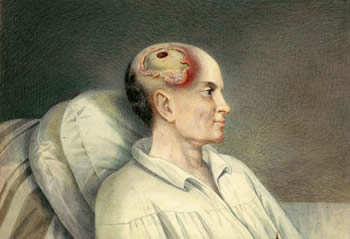
Private Patrick Hughes, 4th New York Volunteers (by E. Stauch, 1863, collection NMHM)
I hope Patrick felt as good as his expression suggests … his wound looks awful in this vivid image. He was painted propped up in a bed at Mount Pleasant Hospital in Washington DC in January 1863 shortly before his discharge from Army service. It had been about 4 months since he’d been shot through the head at the Battle of Antietam. There, a Confederate minie ball had bored through the top of his skull and exited from the back, leaving gruesome-looking wounds, but surprisingly little long-term damage.
Private Hughes‘ story offers some small insight into Civil War medicine and gives me a chance to give the soldier and his unit a little air time.
I found two Patrick Hughes in the Federal Census of 1860 for New York City, both laborers born in Ireland, so it seems reasonable to expect that was our soldier’s background. He enlisted in Company K of the 4th New York Infantry on 25 April 1861, but saw only non-combat duty before he and the Regiment joined General French’s Third Division of Edwin Sumner’s Second Army Corps, Army of the Potomac immediately before the battle of Antietam in September 1862.
So Patrick and his mates were still combat rookies when they crested the rise overlooking the sunken road at the far side of the Roulette Farm at about 9 in the morning of 17 September. The 4th New York were at the left front of the Division in line of battle, and were among the first to run into the concentrated fire of the North Carolina regiments of Anderson’s Brigade, hunkered down in the natural trench of that road. It was probably there that Patrick Hughes was shot.
Although dazed and in shock, bleeding heavily from the scalp, he dragged himself to the rear and received first aid from the regiment’s surgeon, Dr. George W Lovejoy, who reported his “patient was conscious and answered questions rationally.” He was then carried to a barn in Keedysville. He lay there until 20 September, when he was moved to a hospital in Hagerstown.
Otherwise very detailed, his medical history mentions no treatment in those first few days after the battle. Few men survived a serious head wound like his, so he may simply have been expected to die, and not been given any special treatment.
But he was still alive and recovering on 25 September when he was again moved, this time to the Mount Pleasant Hospital in Washington DC.

P. Hughes, 1863 (Lithographs after Stauch in The Medical and Surgical History of the War of the Rebellion, 1870)
On arrival, Assistant Surgeon Thomas Carroll, in charge of his case, reported:
The general condition of the patient was good; suppuration had commenced; no febrile action existed, the pulse was regular, sleep not materially disturbed, mind clear and manifesting no signs of compression of the brain, or inflammation of its membranes. Little, if any, change was perceptible for several days, when the swelling of the scalp and tissues subsided, leaving a prominence nearly, if not altogether, one inch in height, and two and a half or three inches in length of brain substance, in which the pulsation of the arteries could be distinctly observed…
By December, hospital director C. A. McCall, (Assistant Surgeon, USA) noted Private Hughes
… was able to sit up and walk about the ward, and was never afterwards much confined to bed. This protuberance now began to subside, and was soon reduced nearly to a level with the skull; numerous pieces of bone were removed as they became detached from the tissues, leaving a complete channel in the cranium from the point where the ball entered to where it emerged.
He was discharged from the army on 26 January 1863 and went to Newcastle, Delaware on a disability pension of four dollars a month. In 1869 it was doubled to $8, when the examining physician, Dr Maull declared him totally disabled, though Hughes later worked as a “paddler” in an iron foundry, a physically demanding occupation.
We have some fine follow-up information from a pair of Philadelphia doctors who examined Patrick in December 1870, just over 8 years after Antietam, They observed that
His memory is quite good, but by no means so good as before the injury. He is rather easily bothered and confused, and more irritable than formerly. The sight of his right eye, he thinks, is poor. Whisky affects him as usual. Sexual power undiminished. He has no paralysis. The wound of entrance is marked by a slight depression in the bone, the wound of exit by a hollow two and a half by two inches, and one inch deep. No bone has closed this opening, but the scalp and hair dip down into the hollow. The arterial pulsations are barely perceptible.
Remarkably, they had a photograph made of the back of their patient’s head. It’s been preserved in this etching which clearly shows the permanent damage to his skull.
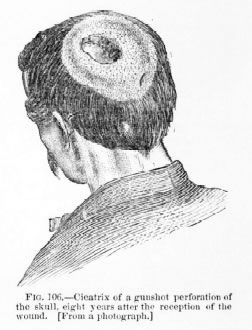
P. Hughes (The Medical and Surgical History of the War of the Rebellion, 1870)
____________
Private Patrick’s Hughes’ unit was the Fourth Regiment, New York State Volunteers.
One of the first units organized at the outset of the Civil War, most of the men were recruited in New York City proper, except for Company E, from Brooklyn. The 4th were nicknamed the First Scott Life Guard in honor of hero-General Winfield Scott, and began their Federal service in early May 1861 for a term of two years.
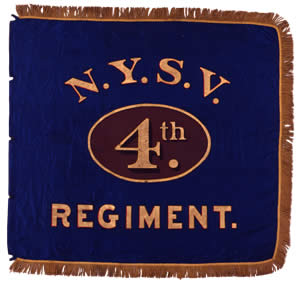
Flank Marker, 4th NY Infantry (NYSMM)
The regiment was on rear-echelon duty at Newport News (Va – June and July 1861), around Baltimore (Md – to June 1862), and at Suffolk (Va – to September) before seeing their first action on the Maryland Campaign. They were in combat again at Fredericksburg in December, and were present, though not engaged, at Chancellorsville in May 1863.
The troops mustered out and were honorably discharged May 25, 1863 at New York City at the end of their agreed-upon term of service.
Phisterer’s chart shows the regiment’s losses in action:
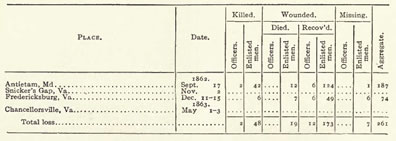
Not as fortunate as Private Hughes, two officers of the Fourth were killed at Antietam.
These are research subjects for a future project, surely, but here’s what I have on them as a first look:
CAPTAIN JOHN S. DOWNS, killed September 17, 1862, in action at Antietam,
Md. Age 32 years; enrolled April 22, 1861, at New York city to serve two years; appointed First Lieutenant, Company G, April 25, 1861; mustered in as such, May 7, 1861; as Captain, Company B, May 26, 1861 (vice Captain May, resigned).
SECOND LIEUTENANT HENRY K. CHAPMAN, died September 17, 1862, of wounds received in action at Antietam, Md. Age 32 years; enrolled April 22, 1861, at New York City to serve two years; mustered in as First Sergeant, Company B, May 9, 1861 ; as Second Lieutenant, December 7, 1861 (vice Lieutenant Thornton, promoted); transferred to Company C, August 15, 1862.
Another person of further research interest, the Regimental Surgeon at Antietam, was
GEORGE W. LOVEJOY, age ? years; enrolled May 27, 1861, at New York City
to serve two years; mustered in as Assistant Surgeon, May 27, 1861 ; promoted
Surgeon, June 14, 1862 (vice Surgeon Wainwright, discharged); mustered out with regiment, May 25, 1863, at New York City;
__________________
Notes
Our story follows–after pulling a couple of link-threads–from a February post by Public Historian Suzanne Fischer. Thanks to her for the pointer to the images of the NMHM which led to this depiction of carnage.
Hughes’ medical story is found in The Medical and Surgical History of the War of the Rebellion, produced under the direction of Surgeon General of the US Army, Joseph K. Barnes in 1870. Hughes’ case is found in Part I, Volume II, pp. 206-7. All 6 volumes of this monumental work have been digitized and posted online at the Internet Archives from originals donated by the National Museum of Health and Medicine (NMHM), Armed Forces Institute of Pathology. Warning: these are huge digital files and can be difficult to work with.
Artist Edward Stauch painted Hughes and other wounded soldiers in Washington DC (under contract?) for the War Department during the Civil War. He is well represented in the Medical and Surgical History. Known as a sculptor and modeler, he was born in Saxe-Coburg, Germany. Stauch was commissioned [c. 1860] to prepare medals for the United States Mint. (From a US Mint kid’s page)
Shortly before the patient's discharge from Mount Pleasant, an excellent picture of the aspect of the injury at that time was made in water color, under the direction of Surgeon J. H. Brinton, U. S. V., who was then in charge of the Division of Surgical Records of the Surgeon General's Office, and had secured the services of an artist, Mr. Stanch [sic], whose admirable drawing and coloring have furnished some of the best illustrations of this book. The figure on the right of the chrome-lithograph opposite [second image from top of this post] is a good copy of Mr. Stanch's water-color drawing [opening painting]. (from Hughes’ case in the History)
Basic information about Hughes’ 4th New York Infantry and the image of the flank marker above are from the NY State Military Museum.
For more about the regiment, I consulted the best single source on New York in the War, Frederick Phisterer’s New York in the War of the Rebellion (3d Ed., Albany: J. B. Lyon Company, 1909-12), also online in its entirety from the IA. The Fourth is found in Volume 2, beginning at page 1738.
If you, like me, take New York in the War of the Rebellion for granted, here’s a photo and tidbit about the compiler to help bring him home:
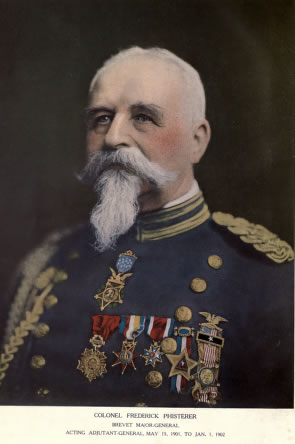
PHISTERER, FREDERICK (1836-1909)
Medal of Honor Citation
Rank and organization: First Lieutenant, 18th U.S. Infantry.
Place and date: At Stone River, Tenn., 31 December 1862.
Entered service at: Medina County, Ohio.
Birth: Germany.
Date of issue: 12 December 1894.
Citation: Voluntarily conveyed, under a heavy fire, information to the commander of a battalion of regular troops by which the battalion was saved from capture or annihilation.

April 2nd, 2008 at 7:48 am
“…under the direction of Surgeon J. H. Brinton, U. S. V., who was then in charge of the Division of Surgical Records of the Surgeon General's Office”
As I’m sure you’re aware, this is none other than the author of “Personal Memoirs of John H. Brinton, Civil War Surgeon, 1861-1865”. He was George Brinton McClellan’s first cousin.
April 2nd, 2008 at 11:32 am
Brian,
Wonderful post. Nice integration of individual and unit history, I really enjoyed it.
April 2nd, 2008 at 12:00 pm
Brian,
I would venture to say that Private Hughes needed that wound like he needed a hole in the head…..
Great story, and well told. Thanks.
Eric
April 2nd, 2008 at 9:46 pm
thanks, all, for popping in.
Harry – I knew of the memoir, and should prob have connected with “Brinton” (ya think?).
Thanks for the kind words Don and Eric. Hole in the head, indeed. As me ol da might have said ‘Good thing that bullet didn’t hit anything important’.
April 9th, 2008 at 7:56 pm
Brian,
Every time I check your blog for an update I keep seeing this gruesome wound jump out from the page at me. Would it be possible to post some new extra lengthy blog entry soon so I don’t lose my lunch next time I visit behind AotW? ;-)
Brett
April 9th, 2008 at 8:24 pm
I’ll do what I can to push that off the page for you, Brett. Thanks for the visit!
May 12th, 2008 at 7:06 am
Quite amazing really that the poor guy even survived. I can vaguely recall reading similar stories about people who had head wounds as a result of the nuclear shockwave at Hiroshima, but that takes the prize.
Many thanks,
Alex
May 13th, 2008 at 7:56 pm
Thanks for stopping in, Alexander. It was his surviving that dreadful wound that caused me to dig into poor Hughes and his life after in the first place. I thought amazing, too.
Best wishes on your blog, by the way. Ferocious subject!
March 10th, 2009 at 10:47 pm
Some of the NC soldiers who were firing on Private Patrick Hughes, 4th New York Volunteers:
http://www.flickr.com/photos/21734563@N04/2662307673/in/set-72157603806079567/
March 10th, 2009 at 10:52 pm
My wifes greatgrandfather was JJ Casey, Co. H 2nd NC Infantry, he was in the sunken road on that day firing at Private Patrick Hughes, 4th New York Volunteers.
JJ Casey:
http://www.flickr.com/photos/21734563@N04/2666922082/in/set-72157603806079567/
October 13th, 2009 at 8:10 pm
My Great Great Grandfather Captain George W. Godfrey was in the fourth and I would love to find a picture of him. Any ideas where I might find one? I have a beautiful picture of his wife, Anna McComiskey, born ~1840 in Ireland.
Any advice would be welcomed.
Thank you,
Kathleen
October 18th, 2009 at 10:55 am
Hi Kathleen,
Good hunting with a photo, tho’ I don’t have any help for you there. Phisterer has the Captain as:
An online genealogist says he died young, in 1865. Do you have any more history on him?
October 18th, 2009 at 2:50 pm
Hello Brian;
Captain George W. Godfrey, served in the 4th Regiment, New York Infantry. From my research Capt. Godfrey and his brother Pvt. James A. Godfrey were in the battles of Antietam, and the Battle of Fredericksburg. I thought he was at Chancellorsville also, but I need to check the date on his Army records to be sure. After he mustered out of the Army he worked as a recruiter in NYC until he died 19 Aug 1867, New York City.
He married to Anna McComiskey and their three children were William James Godfrey, my Great Grandfather, b:22 Jan 1859, Back Bay, Ann Arundel, MD and he died 25 Jun 1951, MA and Mary “Ella” Godfrey and Georgianna Godfrey. Georgianna was adopted since both of her parents were deceased by 1869. Georgianna’s adopted name is Hutton. The Hutton’s resided in New Jersey.
George’s parents were William F. Godfrey, b:~1810, CT d: 27 Sep 1879, Manhattan, NY and Elizabeth Lawrence b: bet. 1814-1815 Philadelphia, PA d: 3 Apr 1883 Manhattan, NY.
Hope this family history will help. And if anyone has knowledge of William F. Godfrey’s parents please post.
Thank you,
Kathleen
November 2nd, 2009 at 8:11 pm
Hi Brian,
Great amazing historical info and illustrations.
Speaking of John H. Brinton… I became fascinated with Brinton’s life and ended up acquiring the original typed manuscript of his Personal Memoirs that Peale Publishing used to for the published book. There are lots of interesting historical specific details left out of that 1917 published book.
Real life historical details are so interesting and important in “real life history”. That’s why your posts is so good.